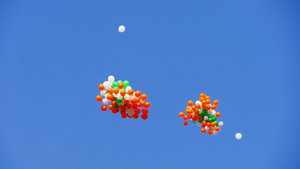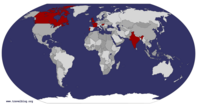Advertisement
Published: February 4th 2016

 Republic Day in Bikaner
Republic Day in Bikaner
Balloons in the colours of the Indian flag rise into the sky from the stadium
The train was already 15 minutes late as it pulled out of Abu Road station just after midday. I’d reserved a second class seat in what’s called '2A Class', an air-conditioned carriage with seats that convert to sleeping berths by night. My seat number was occupied by one of a group of people who insisted that they’d also booked it. They hadn’t of course – they just wanted to sit together. With the train conductor’s help, I was given a vacant berth nearby – in a private compartment still set up for night-time use, with one upper and one lower berth, complete with bed linen. Everyone was happy!
It was a daytime train but, as it noisily click-clack, click-clacked northwards, the scenery was monotonous dry earth, scrub and a few sand-coloured hills interrupted only by occasional litter-strewn towns and villages. It wasn’t long before the curtain at the grubby window was drawn, my head was on the pillow, my body was stretched out on the hard seat and I was covered by a surprisingly-clean white sheet and army-issue blanket.
I dozed on and off, bashed from side to side and top to bottom by the
carriage’s abrupt movements. Eleven hours after we’d left Abu Road, the train pulled into Bikaner – a mere hour behind its optimistic schedule. It was pitch black apart from the platform’s dim lights. A distinct smell of sewage filled the air.
My hotel had sent an auto-rickshaw to collect me
(I always organise a pick-up in advance to save the hassle of having to find transport and haggle over the price – the last things I need after a long journey) and I was soon in a proper bed.
I awoke early the next day, Tuesday 26 January - for a reason. It was Republic Day, one of only three national holidays, this one celebrating the Constitution of India coming into force in 1950. It promised to be a big event, with dignitaries, a parade and a grand display at the huge stadium directly opposite my hotel.
From my first-floor room, I watched all manner of participants enter a side-gate across the road – costumed dancers, motorbikes with contraptions mounted on the back, lorries decked out like carnival floats, smart uniformed soldiers with white cockscomb hats, groups of children in elaborate outfits...
After a hurried breakfast,
I joined the throng of people aiming for the public entrance further along the road. It seemed as though the whole of Bikaner and district were there. It transpired that they were!
From the entrance gate, the crowds were funnelled into narrow entry points, the crush becoming alarming as we all surged forward. The entrance was soon in sight, just a dozen people ahead of me now.
A police officer put up his hand. ‘Sorry, stadium full’, he shouted.
‘Go back, go back!’, he screamed as the annoyed crowd pushed relentlessly towards him.
I was now face to face with him, his eyes displaying alarm that he might be overwhelmed at any moment. Other police officers rushed to his aid, threatening us by raising their four-foot long wooden sticks. The pushing subsided. I wasn’t about to emulate some of the younger element in the crowd who were now scaling the walls and, despite mine being the only white face in the entire place, my pleas to be admitted were met with indifference and further waving of four-foot long wooden sticks! Rats!
Defeated, I returned to the hotel, escorted personally to a side gate by an

 Republic Day marchers
Republic Day marchers
Leaving the stadium after their parade past the assembled dignitaries. Viewed through a telephoto lens from my hotel roof!apologetic policeman. I watched a bit of the parade from afar, from the hotel’s dusty rooftop terrace. I later learned that the highlight of the event had been when four police motorcyclists in a high-speed display collided while trying to do one of those flashy crossover manoeuvres, flying high into the air and landing, mostly unharmed, in a tangled heap. Oh to have been there!
It was now too late for a Plan B this morning, so I organised a taxi to take me later for an out-of-town tour to three places my research had told me were not to be missed.
First, my driver took me 30kms south to the Karni Mata Temple at Deshnok.
Those of a nervous disposition should skip the next few paragraphs – serious mention of rats follows! It’s said that, in the 14th century, Karni Mata in the guise of the god Durga performed miracles, one of which was to bring back to life her son who’d been drowned. However, she reincarnated him as a rat and decreed that all members of her family would return as rats when they died. Many of her descendants still live at Deshnok. They’re all
looking forward to enjoying a new life at the Rat Temple!
Here, hundreds of small grey-brown rats the size of large, well-fed mice scurry about, doze in corners, and merrily eat and drink while bare-footed visitors tread gingerly around them. It’s considered lucky to see a white rat or to have one of the others run across your foot – I didn’t see a white one but numerous others did enjoy looking at my toes. Lucky me!
It’s not a place for the squeamish but it is certainly weird and fascinating.
Next
(and a further warning: this bit refers to dead animals and vultures), we drove back to a remote scrub area outside a small town named Jorbeer. When a domesticated cow, buffalo, horse, goat or whatever dies, the carcass is brought to a dumping station to be devoured by dogs and vultures. In most of the country, dogs are on the increase while vultures have become extremely rare. It transpires that the drug Diclofenac, used to treat animals for inflammatory ailments, is fatal to vultures. With the drug now banned (but still available in limited quantities), the vulture population is struggling to recover. Not so here

 Vultures at Jorbeer
Vultures at Jorbeer
An adult Egyptian Vulture (foreground), a juvenile Griffon Vulture (background) and a Cattle Egret in between themat Jorbeer, where the local council has ensured that only drug-free animals are dumped and, in consequence, vultures abound.
Birds circled high above the dumping area, a barren tract of land with clumps of thorn scrub and little else. A folded 100 Rupee note given in a handshake to an elderly guard admitted us to the area. The car, not equipped for this terrain, skidded along previous vehicle tracks in the sand. My driver warned against getting out of the vehicle because of roaming dogs but two guys on a motorbike – researchers as it happened – waved me over to a group of birds that they were observing.
The air was filled with the sweet stench of rotting carcasses. White ribs and black horns scattered the ground. Among egrets and crows scavenging for maggots among the rotting flesh, vultures – Griffon and Egyptian predominantly – buried their heads beneath pieces of skin searching for the tastiest morsels. An inquisitive Grey Francolin scurried away as I approached. A pair of Woolly-necked Storks waited in line. A Steppe Eagle peered down at us from one of the few trees nearby. It was a macabre sight.
Finally, and with

 Great eyelashes!
Great eyelashes!
At the National Research Centre on Camelsregret that the two researchers asked me not to disturb the birds by venturing closer for a better look (and better photos), I retraced my steps and we moved on to the third of this afternoon’s sights.
This one was the National Research Centre on Camels, incorporating a camel breeding station where three main breeds are reared to maintain important blood lines. I hadn’t realised that there were so many different breeds of camel. Here were hundreds of dark brown, single-humped Bikaneri Camels, the best for milk production, together with similarly-humped light brown Mewari, heavy-legged Kachchhi and athletic, racing Jaisalmeri Camels. There were also a few Bactrian Camels - the hairy ones with two humps.
There was a Milk Parlour there too, the milk cunningly collected by a man with a bucket from one teat while the calf suckled from another. Mum never knew that she'd been robbed!
The milk tasted to me like that awful skimmed cow’s milk my wife drinks, but with a not entirely pleasant, sharp after-taste. It might be better in sugary tea, perhaps. One hump or two, dear?
My next morning in Bikaner was tame in comparison – just a quick
tour by auto-rickshaw to some old havelis (tradesmen’s grand mansions of an age gone by) and the impressive Junagarh, a 16th-century fort built by a general in Mughal emperor Akbar’s army. This decaying edifice stands as a monument to the excesses of that era with its innumerable rooms, vast spaces and opulent decoration. There’s even an old aircraft in the high-ceilinged, pillared Durbar Hall – it’s made up of bits from two De Havilland DH-9 fighters awarded to the then Maharajah of Bikaner by the British government for services rendered during World War I. Bizarre!
After lunch, I’ll be moving on from Bikaner just a half-hour drive south to Gajner, where I’ll be spending a night at a former maharajah’s hunting lodge on a lake.
P.S. This is my 100th blog on TravelBlog, but it's not my last!
Accommodation: Hotel Desert Winds, Opposite the Maharajah Kami Singh Stadium, Bikaner Tel: +911512542202 or +91 9828067400 email: info@hoteldesertwinds.in Web: www.hoteldesertwinds.in I booked through Booking.com but they'll take bookings direct too of course.
I found this 20-room, 3-star hotel adequate but somehow lacking in character, perhaps because I seemed to be the only

 Hotel Desert Winds
Hotel Desert Winds
On the left of the pictureguest. Its website suggests that it’s on its own but there’s actually another similar hotel (Harasar Haveli) right next to it. Its location, however, was probably as convenient as any other for getting around by auto-rickshaw to the Old City and the Junagarh Fort.
My room was clean and comfortable and had all the basic necessities but was rather bare and basic. I stayed for two nights but had to ask for the room to be cleaned after the first night as this did not seem to be done automatically.
WiFi was not usable in the room, but was reasonably good in the ground-floor restaurant.
Apart from in the late morning, when the late owner’s daughter-in-law was in the office, staff were conspicuous by their absence. This was particularly noticeable at breakfast time, when a long wait was necessary. Oh, and a one-bar electric fire was totally inadequate to take the chill off the always empty restaurant.
Cost for a double room for single occupancy was a reasonable 2000 Rupees (about £20) plus 16.4% tax per night.
Advertisement
Tot: 0.11s; Tpl: 0.018s; cc: 15; qc: 31; dbt: 0.0484s; 1; m:domysql w:travelblog (10.17.0.13); sld: 2;
; mem: 1.2mb



























Angie Williams
non-member comment
Scary day
The whole of this day sounded scary with pushing crowds and lots of rats. Rather you than me !!!